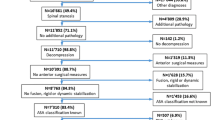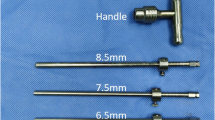Abstract
Purpose
Incidental durotomy is one of the most common complications in lumbar spine surgery. There are conflicting reports whether a dural lesion is associated with an inferior outcome after lumbar decompression. This study analyzed the effect of incidental durotomy in this specific group of patients (Dura+) and compared the results with the remaining cohort without dural laceration (Dura−).
Methods
This prospective multi-center study included 800 patients with lumbar spinal stenosis who underwent exclusive decompression surgery. All procedures were performed as part of a multi-center investigation at three highly specialized spine clinics. Outcome measures (ODI, EQ5D, VASback pain and VASleg pain) were obtained preoperatively as well as 3 and 12 months after surgery. The effect of an incidental durotomy on the clinical outcomes was analyzed statistically between the two cohorts.
Results
An intraoperative dura lesion was recorded in 6.5 % (n = 52/800) of all cases. Both cohorts (Dura+ and Dura−) did not reveal any differences regarding patient demographics, risk factors, or co-morbidities at baseline. The length of the hospital stay was significantly longer for the Dura+ cohort (8.0 vs. 6.4 days; p < 0.01). After 12 months, the Dura− cohort demonstrated a significantly greater improvement in VASback pain in comparison to the Dura+ cohort (Δ21.4 vs. Δ7.2 points; p < 0.05). The differences for the remaining outcome measures were not statistically significant (p > 0.05).
Conclusions
The results of this study reveal that an incidental durotomy was associated with a significant increase in the patient’s length of stay, and risk for re-intervention for the treatment of persisting CSF leakage. In contrast to previous reports which have investigated the effects of incidental durotomies on the clinical outcome after lumbar decompression surgery, our data further suggest a possible inferior outcome in terms of low back pain improvement in the Dura+ cohort, which became clinically apparent at the 12-month follow-up period. Future studies should investigate whether a more pronounced decompression required for adequate exposure and repair of a dural laceration may, ultimately, result in increased segmental instability and in clinically undesirable low back pain.

Similar content being viewed by others
References
Weinstein BK, Tosteson TD, Lurie JD et al (2008) Surgical versus nonsurgical therapy for lumbar spinal stenosis. N Engl J Med 358:794–810
Athiviram A, Yen D (2007) Is spinal stenosis better treated surgically or nonsurgically? Clin Orthop Relat Res 458:90–93
Malmivaara A, Slatis P, Heliovaara M et al (2007) Surgical or nonoperative treatment for lumbar spinal stenosis? A randomized controlled trial. Spine 32:1–8
Papavero L, Thiel M, Fritzsche E, Kunze C, Westphal M, Kothe R (2009) Lumbar spinal stenosis: prognostic factors for bilateral microsurgical decompression using a unilateral approach. Neurosurgery 65:182–187
Podichetty VK, Spears J, Isaacs RE, Booher J, Biscup RS (2006) Complications associated with minimally invasive decompression for lumbar spinal stenosis. J Spinal Disord Tech 19:161–166
Adogwa O, Huang MI, Thompson PM et al (2014) No difference in postoperative complications, pain, and functional outcomes up to 2 years after incidental durotomy in lumbar spinal fusion: a prospective, multi-institutional, propensity-matched analysis of 1741 patients. Spine J 14:1828–1834
Desai A, Ball PA, Bekelis K et al (2012) Surgery for lumbar degenerative spondylolisthesis in Spine Patient Outcomes Research Trial. Does incidental durotomy affect outcome? Spine 37:406–413
Sin AH, Caldito G, Smith D et al (2006) Predictive factors for dural tear and cerebrospinal fluid leakage in patients undergoing lumbar surgery. J Neurosurg Spine 5:224–227
Strömqvist F, Jönsson B, Strömqvist B, Swedish Society of Spinal Surgeons (2012) Dural lesions in decompression for lumbar spinal stenosis: incidence, risk factors and effect on outcome. Eur Spine J 21:825–828
Baker GA, Cizik AM, Bransford RJ et al (2012) Risk factors for unintended durotomy during spine surgery: a multivariate analysis. Spine J 12:121–126
Du JY, Aichmair A, Kueper J et al (2014) Incidental durotomy during spinal surgery. Spine 39:E1339–E1345
Yoshihara H, Yoneoka D (2014) Incidental dural tear in spine surgery: analysis of a nationwide database. Eur Spine J 23:389–394
Grannum S, Patel MS, Attar F, Newey M (2014) Dural tears in primary decompressive lumbar surgery. Is primary repair necessary for a good outcome? Eur Spine J 23:904–908
Mayer HM, Korge A (2009) Microsurgical decompression of degenerative lumbar spinal stenosis. Eur Spine J 18:1989–1990
Gallagher EJ, Liebman M, Bijur PE (2001) Prospective validation of clinically important changes in pain severity measured on a visual analog scale. Ann Emerg Med 38:633–638
Fairbank JC, Pynsent PB (2000) The Oswestry Disability Index. Spine 25:2940–2952 (discussion 2952)
EuroQol Group (1990) EuroQol—a new facility for the measurement of health-related quality of life. Health Policy 16:199–208
Jansson KA, Nemeth G, Granath F et al (2009) Health-related quality of life (EQ-5D) before and after surgery for lumbar spinal stenosis. J Bone Joint Surg Br 91:210–216
Eismont FJ, Wiesel SW, Rothman RH (1981) Treatment of dural tears associated with spinal surgery. J Bone Joint Surg Am A63:1132–1136
Jones AA, Stambough JL, Balderston RH, Rothman RH, Booth RE (1989) Long-term results of lumbar spine surgery complicated by unintended incidental durotomy. Spine 14:443–446
Burks CA, Werner BC, Yang S, Shimer AL (2015) Obesity is associated with an increased rate of incidental durotomy in lumbar spine surgery. Spine 40:500–504
Strömqvist F, Jönsson B, Strömqvist B (2010) Dural lesions in lumbar disc herniation surgery: incidence, risk factors, and outcome. Eur Spine J 19:439–442
Weinstein JN, Tosteson TD, Lurie JD et al (2006) Surgical vs nonoperative treatment for lumbar disk herniation: the Spine Patient Outcome Research Trial (SPORT): a randomized trial. JAMA 296:2441–2450
Epstein NE (2007) The frequency and etiology of intraoperative dural tears in 110 predominantly geriatric patients undergoing multilevel lamincetomy with noninstrumented fusion. J Spinal Disord Tech 20:380–386
Bosacco SJ, Gardner MJ, Guille JT (2001) Evaluation and treatment of dural tears in lumbar spine surgery: a review. Clin Orthop Relat Res 389:238–247
Wang JC, Bohlmann HH, Riew DK (1998) Dural tears secondary to operations on the lumbar spine: management and results after a two-year-minimum follow-up of eighty-eight patients. J Bone Joint Surg (Am) 80:1728–1732
Nandyala SV, Elboghdady IM, Marquez-Lara A et al (2014) Cost analysis of incidental durotomy in spine surgery. Spine 39:E1042–E1051
Copay A, Glassman S, Subach BR et al (2008) The minimum clinically important difference in lumbar spine surgery patients: a choice of methods using the Oswestry Disability Index, Medical Outcomes Study questionnaire Short Form 36, and Pain Scales. Spine J 8:968–974
Parker SL, Adogwa O, Mendenhall SK et al (2012) Determination of minimum clinically important difference (MCID) in pain, disability, and quality of life after revision fusion for symptomatic pseudoarthrosis. Spine J 12:1122–1128
Childs JD, Piva SR, Fritz JM (2005) Responsiveness of the numeric pain rating scale in patients with low back pain. Spine 30:1331–1334
McGirt MJ, Parker SL, Asher AL, Norvell D, Sherry N, Devin CJ (2014) Role of prospective registries in defining the value and effectiveness of spine care. Spine 39:S117–S128
Strömqvist B, Fritzell P, Hägg O, Jönsson B, Swedish Society of Spinal Surgeons (2009) The Swedish spine register: development, design and utility. Eur Spine J 18:S294–S304
Sigmundsson FG, Jönsson B, Strömqvist B (2015) Outcome of decompression with and without fusion in spinal stenosis with degenerative spondylolisthesis in relation to preoperative pain pattern: a register study of 1624 patients. Spine J 15:638–646
Mullholland RC (2016) The Michel Benoist and Robert Mulholland yearly European spine journal review: a survey of the “surgical and research” articles in the European spine journal, 2015. Eur Spine J 25:24–33
Papavero L, Engler N, Kothe R (2015) Incidental durotomy in spinal surgery: first aid in ten steps. Eur Spine J 24:2077–2084
Author information
Authors and Affiliations
Corresponding author
Ethics declarations
Conflict of interest
None.
Rights and permissions
About this article
Cite this article
Kothe, R., Quante, M., Engler, N. et al. The effect of incidental dural lesions on outcome after decompression surgery for lumbar spinal stenosis: results of a multi-center study with 800 patients. Eur Spine J 26, 2504–2511 (2017). https://doi.org/10.1007/s00586-016-4571-8
Received:
Revised:
Accepted:
Published:
Issue Date:
DOI: https://doi.org/10.1007/s00586-016-4571-8




